INTERDEPARTMENTAL CIVILIAN/MILITARY COOPERATION
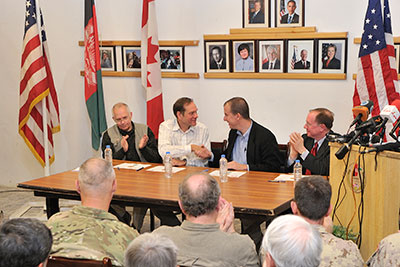
DND photo AR2011-0011-082 by Corporal Jean-François Carpentier.
The outgoing Director of the Kandahar Provincial Reconstruction Team (KPRT), Tim Martin, Representative of Canada to Kandahar, and the incoming Director, Ben Moening, shake hands during the Transfer of Authority (TOA) of the KPRT to the USA, 12 January 2011.
Canada’s Whole of Government Mission in Afghanistan ~ Lessons Learned
by Kimberley Unterganschnigg
For more information on accessing this file, please visit our help page.
Lieutenant-Colonel Kimberley Unterganschnigg, MMM, CD, MSc, MA, is a Logistics Officer who has accumulated considerable overseas experience with the UN and NATO. She was deployed as the Joint LessonsLearned Officer for Task Force Kandahar from September 2010 to July 2011. She is grateful to her WoG colleagues who helped prepare and edit the report.
Introduction
As the end of Canada’s Whole of Government (WoG) mission in Afghanistan approached, a workshop was convened with civilian and military members of the Kandahar Provincial Reconstruction Team (KPRT) and Task Force Kandahar Headquarters (TFK HQ) to discuss lessons learned and best practices from field-based operations, which fed into a larger Privy Council Office WoG lessons learned exercise. The workshop included representatives from all key departments, including the Department of National Defence (DND) and the Canadian Forces (CF), the Canadian International Development Agency (CIDA), the Department of Foreign Affairs and International Trade (DFAIT), the Royal Canadian Mounted Police (RCMP) and Correctional Services Canada (CSC), involved in the WoG mission. This article presents the findings and recommendations that arose from this workshop.
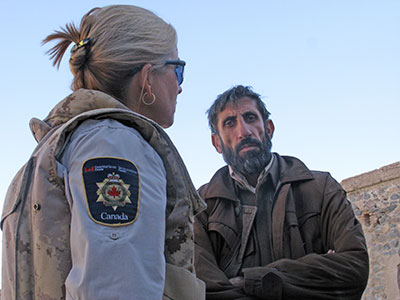
DND photo IS2008-7407 by Captain Adam Thomson
Correctional Service Canada Representative Paula Milino speaks with the Director of Education and Training, Colonel Mohammad Ismail, at the Sarpoza Prison in Kandahar City,
17 November 2008.
Background
The 2008 Manley Report1 provided the context and rationale for Canada’s largest foreign policy involvement since the Korean War. Led by the Privy Council Office, Canada’s WoG effort operated under a Memorandum to Cabinet that provided strategic vision2 and six priorities3 for participating government departments. This document represented Canada’s grand strategy for Afghanistan, and, as such, did not delineate how the departments would collaborate in the field; this level of detail was left to WoG representatives in Afghanistan to determine. Quarterly reporting to Parliament4 focused upon progress in relation to benchmarks5 for each of the priorities, including three signature initiatives.6
There are numerous studies focusing upon the benefits of a WoG approach to programming in a fragile state. These studies emphasize the importance of having a unifying strategic vision and a shared understanding of the mission’s goals and objectives.7 They further conclude that policy coherence at the strategic level should be combined with a clear understanding of each department’s roles and responsibilities, enabling the team on the ground to prioritise and to de-conflict activities. Coherence should also extend to financial policies and common funding mechanisms.8 Specific lessons from the United States (US) and the United Kingdom (UK) on the functioning of PRTs, as well as a 2009 report on the Canadian WoG experience reinforced this need for coherence from the strategic to the tactical level.9 Further recommendations common to all of these reports are the requirement for: an integrated structure; common IT systems; physical collocation of the civilian and military elements; joint civil-military planning; and pre-deployment training to familiarize each department with the roles and responsibilities of the others, as well as to exercise these through scenarios.
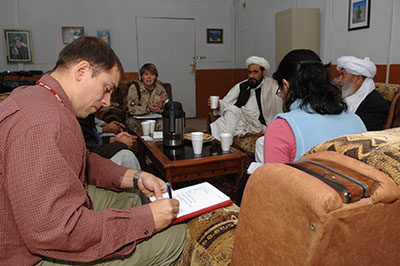
DND photo IS2007-0728 by Master Corporal Robert Bottrill
Nicholas Gosselin, Political Officer for the Department of Foreign Affairs working with the KPRT, records notes during an exchange of information with Afghan officials regarding the functioning of the Afghan justice system, 29 November 2007.
Various models have been developed to guide the planning and de-confliction of civilian and military operations at the tactical level, often in the absence of strategic level vision and guidance. Early in 2011, the Regional Platform South (US Department of State, US Agency for International Development) and Regional Command South (International Security Assistance Force - ISAF) revised the Stability Continuum10 to guide programming by the coalition militaries and the civilian department/agencies in the region. Called the Region South Stability Approach, it included the phases of the Stability Continuum (Shape, Clear, Hold A, Hold B, and Build/Transfer); sector-specific frameworks;11 and a uniform Provincial-District Stability Framework12 developed jointly by the civilian departments/agencies and the military. This was very much a ‘bottom-up’ response within theatre to the need for a mechanism for coordination of civilian, military, and coalition activities. The tool was based upon recent experience, and was used to coordinate the security and development efforts by commanders in the field, Provincial Reconstruction Teams (PRTs), and District Stabilization Teams (DSTs).13
It must be noted that major shifts occurred to TFK’s area of operations in early- 2010. With the influx of troops generated by the US surge, TFK’s responsibility decreased from the whole of Kandahar Province to three districts: Daman, Dand, and Panjwa’i. This shift resulted in a divergence between the KPRT’s area of responsibility, which was dictated by the longer-term goals represented by the six priorities and three signature projects throughout the entire province, and TFK’s focus upon its assigned districts. As a result, the KPRT and TFK main efforts were no longer aligned, and occasional friction arose. As the transition towards a US lead of the KPRT progressed, this divergence became somewhat more noticeable. It did not, however, impair the ability of TFK and KPRT to support each other’s activities. The comments which arose from the discussions are evidence of this success and of the importance of strong inter-personal relationships in achieving this success.14
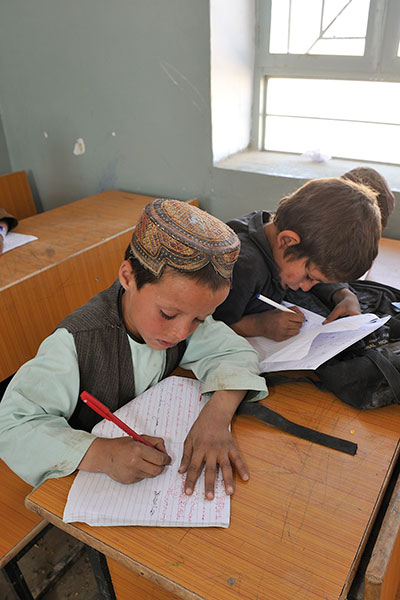
DND photo AR2011-0099-019 by Corporal Jean-François Carpentier.
The Gorgon village school in the Dand district, after opening on 23 December 2010, was further improved by Canadian contingency funds administered by Canadian Civil-Military Cooperation (CIMIC) teams.
Findings and Recommendations
The findings and recommendations that arose from the workshop have been grouped into six themes that are common to the literature: vision/goals/strategy; organizational structure and accountability; processes, mechanisms and agreements; people/culture/relationships and training; budget/funding/ contracting; and communication and information technology. Although the recommendations are derived from the Afghan experience, most are considered applicable to future WoG missions in fragile states.
Vision/Goals/Strategy
International and National Goals and Strategy
Inconsistency in strategies at the international and national (Canadian) levels, such as strategies for the rule of law sector, impeded progress in security, governance, reconstruction and development. Although the Afghan National Development Strategy resolved many of these issues, it was apparent that a more detailed international strategy and framework was required to coordinate the efforts of the international allies and the affected host nation ministries, including the establishment of agreed upon principles. This would have ensured consistency in training of host nation personnel across the country and sustainability of projects and initiatives. In the Canadian context, the national Memorandum to Cabinet, framework and campaign plan should have established clear objectives and benchmarks that served to coordinate the efforts and priorities of the departments, throughout the mission, in support of the international strategy. The lack of a clear international strategy and clearly defined roles for the departments led, at times, to friction between WoG departments in Kandahar as to their roles, responsibilities and priorities, particularly where there tended to be an overlap between stability and development activities. There was also occasional friction between a department’s priorities and that of its Government of the Islamic Republic of Afghanistan (GIRoA) partner. Much of this friction could have been avoided through the establishment of a policy framework, based on host government priorities, that provided effects/results (and measures/indicators) that were meaningful. In future such a framework should be developed to form the basis of a unified WoG architecture for planning, monitoring, and reporting, thus ensuring focus and consistency throughout the mission. Furthermore, an internationally or at least nationally agreed approach to missions in fragile states, based upon a tool such as the stability continuum, should be put in place to provide clarity on roles and responsibilities of each department, particularly with respect to activities in support of governance and development.
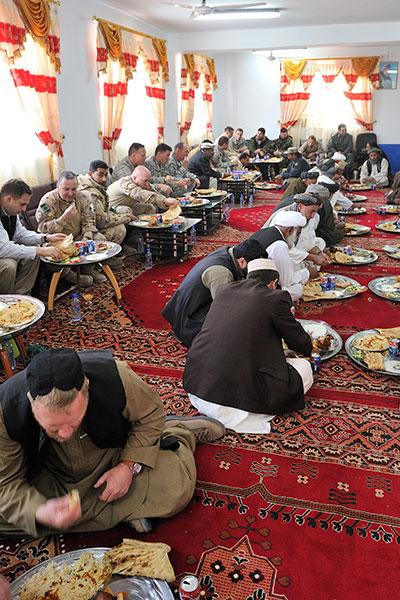
DND photo AR2011-0050-067
Shura in the Panjwa’i district.
Our National Goals versus the Host Nation
Although there was tacit recognition that tactical patience was required, overly ambitious objectives and plans on the part of coalition forces sometimes tended to hamper the development of governance capacity. In some cases, the international community’s interest in getting results superseded the medium and longer term goal of developing GIRoA’s capacity to connect to its people and deliver services. To address this, the host government, particularly at the local level, should be involved in the planning process, at a minimum, to get their ‘buy-in’ or concurrence, even when rapid progress/action is required. Whenever possible, time should be built into the decision-making process to enable them to make a significant contribution to the plan and its implementation.
It may be that letting the host government drive progress means that we need to adjust our own expectations of what can be achieved in a particular rotation. Careful planning needs to occur to determine with whom each organisation should be working at each stage of the stability-development spectrum, and to develop a strategy to accomplish these objectives. We also need to find ways to support the host nation government’s capacity to plan at the strategic and tactical level, and to implement at the provincial and district level. On the military side, the last Canadian task force headquarters notably determined to continue initiatives begun by the previous headquarters, a marked departure from the tendency towards ‘roto-it is’ that had caused significant changes in approach to governance, reconstruction, and development from headquarters to headquarters.
The Host Nation versus itself: National Priorities versus Local Requirements and us in the middle
There was a significant disconnect between Kabul-driven GIRoA policy and expectations, and what was needed at the Provincial and District levels. The WoG team tried to implement strategies and policies created in Kabul that were too complex, un-resourced, or inappropriate, and that may prove to be unsustainable. There was also a significant gap between what the locals understood about the role of each level of government, and what Kabul intended. This was further complicated by a disconnect between Canadian stability and development objectives. Our approach to building expectations and coordinating governance capacity must better reflect our understanding of the appropriate balance between the host nation’s longer term sub-national governance policy priorities and local needs. In particular, applying development principles (that focus upon Host Nation-driven medium and long term effects or results) in a counter-insurgency environment (that focuses upon immediate local effects) remains one of the key challenges facing the WoG effort to put the Host Nation Government ‘in the driver’s seat.’ Instead of the Canadian ‘six and three’ type of national goals, there needed to be a WoG strategy and plan that identified potential activities that could be used in a coordinated fashion by the departments (especially the CF, CIDA, and DFAIT) as the environment moved through the phases of the stability spectrum.
Civilian-Military Organizational Structures and Accountability
Within TFK Headquarters, there was a unified organizational structure. However, the roles and responsibilities of the civilian staff members from the other government departments were not clearly defined, and the expectations of the military branch heads and these civilian staff as to their roles sometimes diverged. This was exacerbated by the small number of civilian staff employed in the headquarters, which limited the availability of expertise from the other government departments to military branches responsible for planning stability operations, including those with clear governance and reconstruction impacts. The employment of a senior military liaison officer and military engineering and support personnel within the KPRT provided the KPRT with ready access to military advice. It became apparent that, in a WoG effort, both the civilian and military headquarters must be appropriately staffed with sufficient, qualified, and experienced personnel from key departments who have clearly defined roles and responsibilities.
There is need for more clarity with respect to civilian-military roles and responsibilities in terms of who leads and who supports a particular issue or file, in order to avoid the perception of ‘too many bosses,’ and to prevent unnecessary infighting. While the relationship between the senior civilian in Kandahar, the Representative of Canada in Kandahar (known as the RoCK), and the military commander was stronger than had been the case in some earlier rotations, with the shifting of the RoCK to the KPRT, there was a loss of consistent direction from the top, resulting in unnecessary duplication of effort. There was also a perception of too much ‘push’ from the military side on core governance, reconstruction, and development issues. Leadership is critical when there are somewhat parallel organizations whose lines of responsibility intersect. The senior civilian representative and the military task force commander need to be seen to be visibly cooperating and to be acting upon a coordinated strategy. They should be collocated wherever possible, or where this is not possible, liaison mechanisms should be put in place (meetings, liaison officers) to ensure consistent messaging and a clear division of responsibilities.
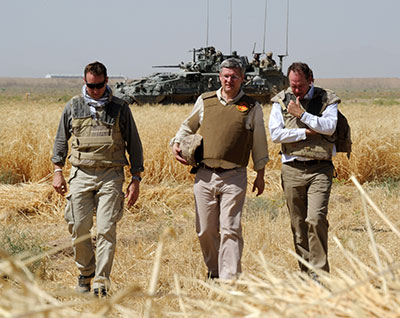
DND photo IS2011-1012-20 by Sergeant Matthew McGregor
Canada’s Prime Minister, the Right Honourable Stephen Harper, the Canadian Minister of National Defence, the Honourable Peter MacKay, and Tim Martin, Canada’s Representative in Kandahar, walk through the wheat fields at Tarnack Farms near Kandahar City during a surprise visit,
30 May 2011.
Processes – Mechanisms and Agreements, including Planning
Although the ‘value-added’ of each department was recognized, the different pace and priorities of the civilians and the military created challenges when developing a common approach to planning, decision-making, on-going management of governance, reconstruction and development issues, as well as reporting. Effort needs to be made to design work processes that require contributions from civilian and military colleagues that result in WoG products that are efficient and effective. These processes should range through all levels of operational planning and reporting, down to project design and implementation. Physical co-location of civilians and the military proved to be invaluable in enabling collaboration, with the district stabilization team emerging as the most effective civilian-military structure. In each case, departments were able to work effectively together on projects, with each adding value through contributing their expertise and resources. The success of this approach reinforces that, wherever possible, WoG teams should be established and developed. At a minimum, the civilian and military organizations should be collocated to enable the development of effective networks.
With the geographical separation of the KPRT and TFK headquarters, the reduction of the task force’s area of operations, and the increasing emphasis placed upon governance, reconstruction, and development, the TFK Commander decided to deploy a liaison officer to the KPRT. In turn, the RoCK’s deputy, the Senior Civilian Representative, was assigned to TFK Headquarters in order to provide strong linkage to the civilian departments. These officers were senior, highly experienced members of their respective departments. The employment of liaison officers, who have the appropriate levels of seniority and experience, as well as experienced officers at the working level between the military and civilian headquarters should be considered wherever collocation is not possible.
There was widespread recognition that civilians and the military work at different parts of the stability continuum and they overlap at some stages; differences in departmental approaches to and pace of planning, tasking and reporting were also evident. It is important that the relationship between security, stabilization, and development be better understood by each department, and that the approaches and activities of each department through the stages of the stability continuum are well coordinated. For example, TFK used cash for work projects as part of ‘shape, clear, and hold,’ in order to provide employment and address infrastructure requirements. Focusing these projects upon key economic infrastructure (roads, irrigation canals) can be used to enable development activities in support of promoting economic growth, whenever the security situation permits.
The need for increased civilian-military integration became apparent in an unexpected manner. The civilian members of the other government departments had very restricted freedom of movement, which impaired their ability to meet with GIRoA officials and to participate in important activities away from the District Centre and KPRT. As such, military members were the primary representatives of the WoG team ‘outside the wire.’ In order for military members to be effective and consistent with the WoG messaging, they needed to be integrated into networks with the civilian departments. Departments such as CIDA and DFAIT need to re-examine their limitations on the movement of their civilian staff during stability operations. DND’s policies are more flexible, and they enable DND civilian staff, such as language and cultural advisors, as well as science advisors, to move wherever their duties demand of them.
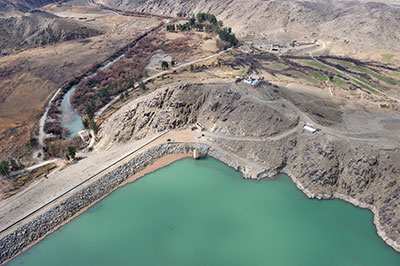
DND photo AR2011-0061-066 by Corporal Jean-François Carpentier
The Dahla Dam and irrigation system, one of three Canadian signature projects in Afghanistan.
Developing Host Nation Capacity
The WoG team developed a number of approaches to support GIRoA, including mentoring, training, support to the governance, reconstruction and development process and projects responsive to the needs of the population. For example, the local communities were encouraged to select leaders to engage with the district government in order to bring forward their requirements for projects. The district stabilisation teams then worked with the district governments to prioritize these requirements, and to match them to national or provincial plans, or recommend them for funding by the military (Canadian Commander’s Contingency Fund or the US Commander’s Emergency Response Program),15 or the programs put in place by civilian agencies (CIDA, DFAIT, and USAID). These approaches encouraged the development of a nascent capacity to deliver basic services to the population at the provincial and district level. The WoG team needs to be flexible in order to capitalize upon emerging opportunities, and yet, to have a sufficiently stable approach to ensure continuous progress, from rotation to rotation.
In time, and based upon the excellent relationships established with our GIRoA counterparts, the WoG team was able, in some cases, to shift the focus of our support, from shaping, to mentoring, to advising, emphasizing the principle of putting the Afghans first, from face to voice, to action, to ownership. This is significant. As the host nation partners progress, the WoG team must be prepared to step back from doing, to leading, to mentoring, to advising. The WoG team must also be comfortable with “letting their host nation partners fail” – recognizing that this too is a developmental opportunity.
We were late to work with Kabul and the Provincial governance system to ensure that there were financial resources available to support their operations. This hindered our ability to help the provincial /district and local government and ministry representatives build financial management and planning capacity. Financial resource management skills should be developed as early as possible at the provincial and district levels, with clear and streamlined processes put in place to receive devolved operating budgets. This could be accomplished through the introduction of projects and programs using different program mechanisms put in place by the WoG team, as well as through mentoring at all levels of the government.
Reporting
The weekly reports from the district stabilization teams were incorporated, with input from the civilian and military staffs, into a single, WoG, weekly situation report from RoCK and Comd Task Force Kandahar. This reporting activity served to create a shared understanding of the key issues and a common acceptance of priorities. A unified WoG reporting structure, based upon a shared set of effects or results, and indicators or measures, should be established prior to deployment, and then continued for every rotation throughout the length of a given mission.
The Bi-National PRT
The bi-national KPRT was an exceptional example of a unified organizational structure, starting with the command structure, and percolating down to each section. This resulted in a high degree of trust and extremely strong relationships, enabling each section to develop an effective approach to supporting GIRoA. Because of the KPRT’s unified organisation, they were able to develop complementary programming efforts that reflected integrated decision-making, planning, and chain of command. This was typified by the development of sector-specific working groups that proved to be tremendous assets for coordinating activities across sections, and between the KPRT and the regional coalition structures (such as Regional Command South). As soon as is practicable, sector-specific working groups that pull participants from all departments and each of the nations participating in the provincial (or subnational) reconstruction teams, should be established as a basic coordination mechanism to work on particular issues.
These bi-national, interdepartmental working groups were often able to draw funds from either national program. However this occasionally led to confusion with GIRoA partners as to whom their implementing partners were for reporting purposes. In a bi-national PRT environment, the development of pooled funding would enable close alignment of both countries’ current and future programs in support of the host nation’s priorities. This would also reduce transaction costs for host nation partners when accessing financial and technical support from the Coalition.
Interestingly, the Americans relied heavily upon Canadian service support for the KPRT. This led to an undue burden being placed upon the limited Canadian staff. There was also a delay in transition of these responsibilities, as the US did not have their support arrangements in place until quite late. In a bi-national or multinational PRT, a clear set of roles and responsibilities, particularly with respect to common services (i,e., visits, accommodation, movements), would ensure a more balanced distribution of effort and a more seamless transition, should one of the coalition nations depart.
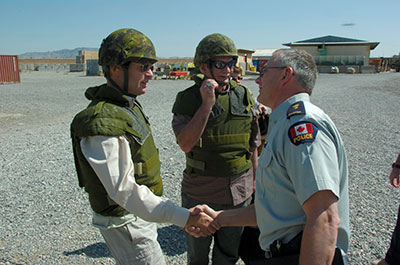
DND photo AR2007-A038-0004 by Sergeant Craig Fiander
The Kandahar Provincial Reconstruction Team’s Senior Police Advisor, RCMP Superintendent Dave Fudge, greets the Honourable Stockwell Day, Minister of Public Safety, and the Honourable Vic Toews, the Treasury Board President, shortly after their arrival at the KPRT’s Camp Nathan Smith, 2 April 2007.
People/Culture/Relationships and Training
While all civilians who deployed were able to participate in a limited amount of training with the military, there were no opportunities for the military to train with their colleagues from the other departments. As a result, there was a general lack of understanding of each others’ organisations, cultures, roles and responsibilities, and work methods. Ideally, the Government of Canada (GoC) should establish an independent Centre of Excellence for Fragile States, in order to build on lessons learned from the WoG effort in Afghanistan. This Centre of Excellence would be an interdepartmental platform staffed with personnel with significant security, governance, and development expertise in fragile states. Building upon lessons learned and best practices, this formation would permit the GoC to prepare for future missions in other troubled areas, ensuring that these missions would benefit from building upon the civilian-military policies, practices (including programming), and organizational structures developed in Afghanistan.
Given the current fiscal environment, at a minimum, personnel selected for deployment from all of the departments should participate in several weeks of each other’s pre-deployment training. Collective pre-deployment training enables relationships to be built, roles and responsibilities to be defined, and the potential contribution each organisation can make to the mission to be clearly communicated. Pre-deployment training should include exposure of DND staff to development principles, and exposure of civilian staff to the rigours of the DND planning process.
Opportunities for interdepartmental training and deployments into other departments should also be promoted in order to develop a cadre of personnel with experience working in a Whole of Government environment. This would contribute to establishing effective networks of interpersonal relationships and improved cross-cultural communication between the departments.
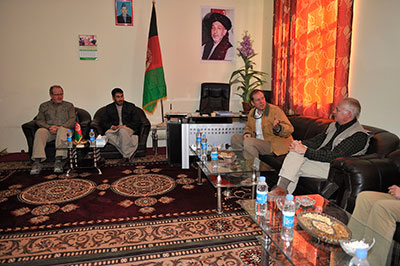
DND photo AR2011-0011-040 by Corporal Jean-François Carpentier
Wayne Wouters, Clerk of the Privy Council, Ahmadullah Nazak, Dand District Governor, Tim Martin, Representative of Canada to Kandahar, and William Crosbie, Ambassador of Canada in Afghanistan, hold a meeting, 12 January 2011.
Team Composition
In many cases, the WoG team either did not have the appropriate experience to provide the technical advice and training to GIRoA officials (i.e., to a Governor or to a Director of Agriculture, Irrigation, and Livestock), or they were unaware of Afghan legislation and guidelines (i.e., the sub-national governance policy). Ensuring that the team had the right skill mix to provide the support needed, particularly for officials at the Provincial and DG levels, would have increased our impact. In the future, a thorough assessment of the partner government’s needs, supported by a proactive recruitment, staffing, and training approach within the WoG departments, should be conducted to ensure that we provide the very best technical advice. Furthermore, WoG missions in fragile states should include the involvement of each department whose specialist expertise is required by the host nation (i.e., justice, agriculture).
Budget/Funding/Contracting
Delivering activities quickly in hostile and insecure environments necessitates a great amount of flexibility in contracting and funding procedures. Indeed, contracting and financial policies and procedures need to be developed to suit the context of the operational environment. DND’s enhanced financial delegations, use of the ‘Afghan First’ principle, and the ability to pay contractors through local banks are best practices that should be captured in interdepartmental policies and procedures for future operations. The flexibility and responsiveness of CIDA’s Kandahar Local Initiatives Fund, and DFAIT’s Global Peace and Security Fund were unparalleled among the international community, and they should be adopted as the funding model for supporting local priorities. To maximize our ability to effectively use the various funds available, common practices should be adopted by all departments in the field, and ideally, a centralized common service unit (finance and contracting) should be established.
Successful contracting often depends as much upon the host nation government’s rules and regulations as upon our own. One of the key impediments to completion of several contracts was our lack of knowledge of GIRoA tax regulations, and therefore, our failure to include a tax clause in the contracts. To alleviate this problem, and support their capacity development, the host/local government should be involved in the contracting process as early as possible, preferably with the development of the Statement of Work.
One of the problems that arises almost without fail in multinational operations is competition between coalition partners for host nation human resources, particularly skilled employees. This competition drove up prices and salaries, robbing GIRoA of qualified candidates. Coordination is required with the government and coalition partners to avoid negative impacts upon the local economy and governance. This coordination requires consultation, at a minimum with coalition forces, during early stages of operational planning.
Information Technology
The bi-national KPRT and TFK Headquarters were faced with a plethora of information technology systems that could not interface effectively with one another, and for which some staff did not have the appropriate security clearances or accounts. This was compounded by the different unclassified systems used by the civilian departments and the military. A common information technology platform, where information could be stored and shared (similar to SharePoint sites), would have significantly improved the overall effectiveness of communication within and between the organizations, while reducing the time spent by staff managing, transferring, and re-doing work done on a variety of systems.
Strategic Communications
As demonstrated by DND, an effective communication strategy requires the tools to capture imagery, and the freedom to engage the media as events arise. Because the CF has dedicated imagery capability (Combat Camera), an embedded media program managed by the task force headquarters’ public affairs officer, and permission to tell their story, ‘military’ stories dominated the press. The other departments did not have this capability, and they were required to go through a complex process for approval to speak to media. As a result, their stories were almost unheard. It is important that all departments be given the latitude and tools required to communicate effectively with the press and the Canadian public in order to properly portray the WoG effort.
One of the great successes was the cooperation of GIRoA and the GoC on the establishment and training of staff of the Government Media Information Centre (now the Kandahar Media Information Centre) and District Public Affairs Officers. These capabilities truly enabled GIRoA to communicate effectively with the populace and to counter Taliban propaganda. A further initiative, training Public Affairs Officers within the Afghan National Army, also led to a stronger connection between the population and its army. Building the capacity of the host government to communicate with its people should be considered an essential element of similar COIN and stabilisation missions. It can produce a large impact for a relatively small investment in human and financial resources.
Conclusion
Interdepartmental civilian-military cooperation was essential to address the broad scope of security, governance, reconstruction, and development activities that were undertaken by the KPRT and TFK in the final year of Canada’s involvement in Kandahar. Looking back, rather than a strategy document focused upon fixed signature projects, a more comprehensive framework and approach to the WoG mission that provided clarity on the roles and responsibilities of each of the departments, particularly with respect to activities in support of governance and development, would have improved our effectiveness, as it would have guided consistent progress over the years.
Overall, the WoG Team’s ability to support the development of the governance capacity of key officials within the provincial and district levels of the GIRoA, and therefore, GIRoA’s ability to reach the villages, benefitted from the expertise provided from each of the participating departments. However, expertise was lacking in key areas, such as justice and agriculture. Further, even though there was a degree of civilian-military integration, increased integration would have improved our overall effectiveness, beginning with integrated pre-deployment activities and training, through to an organizational structure that included more civilian-military integration at the strategic (Commander and Representative of Canada) and tactical (units/sections) levels. One area of friction noted was that, at times, our desire to show immediate results or to achieve required tactical effects meant that we led GIRoA more than we supported their lead. Friction also arose at times due to overlapping roles and responsibilities of the various departments involved in governance, reconstruction, and development. The dedication of civilian and military personnel ensured that these frictions did not interfere with their mission, which was to successfully wind down GOC programming, while leaving Afghans with a stronger capacity to provide security and deliver basic services to their population.
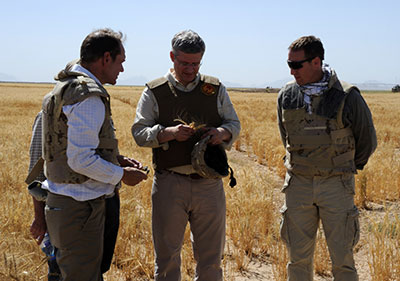
DND photo IS2011-1012-21 by Sergeant Matthew McGregor
Tim Martin, the Representative of Canada in Kandahar, the Right Honourable Stephen Harper, Prime Minister of Canada, and the Honourable Peter MacKay, the Canadian Minister of National Defence, examine some of the wheat grown at Tarnack Farms near Kandahar City, 30 May 2011.
NOTES
-
The main rationale for Canada’s involvement in Afghanistan per the Manley Report is to counter the terrorist threat following on from 9-11. The report also discussed how Canada became involved in Kandahar, starting with 850 troops to support Operation Enduring Freedom in 2002, followed by assuming the leadership of the Kandahar Provincial Reconstruction Team in 2005. The report provided a number of suggestions, including the need for a ‘ramped up’ WoG civilian-military effort led by the Prime Minister, and the importance of ‘signature projects,’ so that Canada’s contribution would be more readily identifiable.
-
“A more secure Kandahar that is better governed and can deliver basic services to its citizens, supported by a more capable national government that can better provide for its security, manage its borders and sustain stability and reconstruction gains over the longer term.”
-
The six priorities were: Security; Basic Services: Humanitarian Assistance; the Border, National Institutions; and Political Reconciliation. Lead departments were identified for each priority, with the exception of National Institutions, which was shared by the Canadian International Development Agency (CIDA) and the Department of Foreign Affairs (DFAIT).
-
Canada’s Engagement in Afghanistan consists of a narrative, supported by an Appendix providing details on progress for each of the six priorities.
-
Recognizing that programming is a challenge in a fragile state, a set of benchmarks or reference points was established to help assess progress in priority areas. Some were quantitative (numerical), while others were qualitative (perceptions or assessments on the implementation of policies and programs).
-
The Dahla Dam and Irrigation System ($50M). Education ($12M). Polio Eradication ($60M).
-
Stuart Gordon, “The UK’s Stabilisation Model and Afghanistan: Assessing the Impact on Humanitarian Actors,” in Disasters, Vol 34, Issue Supplement S3, pp. 368-487, dated 16 September 2010; Gavin Buchan, “Breaking down the Silos: Managing the Whole of Government Effort in Afghanistan,” in the Canadian Military Journal, Vol. 10, No. 4, Autumn 2010; Centre for Army Lessons Learned, Complex Operations II Newsletter, November 2010; UK Stabilisation Unit, “Responding to Stabilisation Challenges in Hostile and Insecure Environments: Lessons Identified by the UK’s Stabilisation Unit,” November 2010, at www.stabilisationunit.gov.uk, accessed 20 January 2011; Chief Review Services, Evaluation of CF/DND Participation in the Kandahar PRT, Final Report 1258-156 (CRS) December 2007; Willemijn Keizer, Review of Existing studies and Evaluations of Whole of Government Integration and Operations, March 2009; Robin Hart, Report on Wilton Park Conference 895 – Civil-Military Co-ordination in Complex Humanitarian Situations, April 2008, at <http:docstoc.com/docs/10899190/Report-on-Wilton-Park-Conference-895-CIVIL-MILITARY-CO-ORDINATION>, accessed 8 March 2011.
-
Cristina Hoyos and Robert Muggah, “Can Coherent, Coordinated and Complementary Approaches to Dealing with Fragile States Yield Better Outcomes?” in Politorbis Nr. 46, 1/2009.
-
Center for Complex Operations, PRT Interagency Lessons Learned Project, October 2010; UK Stabilisation Unit, “Responding to Stabilisation Challenges in Hostile and Insecure Environments: Lessons Identified by the UK’s Stabilisation Unit”, November 2010, at www.stabilisationunit.gov.uk, accessed 20 January 2011; Theatre Lessons Report (TLR) 09-032 “Comprehensive Approach in JTF-Afg (TFK HQ 5-09) Whole of Government Team in Stabilization Operations,” dated November 2009.
-
Refer to Canadian Land Forces Counter-Insurgency Operations B-GL-323-004/FP-003 Chapter 5, Section 4, US Army Field Manual, FM 3.24 “Counterinsurgency Operations,” and the UK Army Field Manual “Countering Insurgency” Volume 1, Part 10.
-
Rule of Law, Governance, Health and Education, Agriculture and Economics, Infrastructure, and Security.
-
The Stability Framework is used as a civil-military tool to coordinate the marshalling and prioritization of resources and efforts—by sector. Done in partnership with GIRoA counterparts and in consultation with District Stabilization Teams as appropriate, the Framework will inform the updating or development of District Stabilization Plans for priority districts. These plans will be incorporated into GIRoA 2011 Provincial and District Plans.
-
The Stability Continuum is driving district planning efforts by: identifying in which phase a specific district currently lies; and aiding the selection of the most appropriate combination of security, development, and governance activities needed to advance to the next phase. For instance, the ‘shape’ phase of the continuum can be characterized by a security environment that is unsecure and the lack of ANSF capacity - resulting in a dangerous environment. Simultaneously, governance may be limited and the population hostile, suspicious and/or unwilling to cooperate with GIRoA/ISAF/ANSF. Economic development may be low or non-existent. Together, these characteristics are useful to identify an appropriate set of activities and/or projects, and to guide district-level and below planning efforts by military and civilian actors.
-
The importance of inter-personal relationships to building unity of effort in the civilian-military environment in Afghanistan was previously noted by Howard Coombs and General Rick Hillier in “Command and Control during Peace Support Operations: Creating Common Intent in Afghanistan,” in: Allan English (ed.), The Operational Art: Canadian Perspectives on Leadership and Command (Kingston, ON: Canadian Defence Academy Press, 2006), Chapter 8.
-
The Canadian Commander’s Contingency Fund, and the US Commander’s Emergency Response Program have similar purposes. They provide commanders funds for humanitarian relief and reconstruction activities. The Canadian Commander’s Contingency Fund may be used to advance military objectives in aid of a particular mission, and may also result in positive and tangible effects related to fostering governance, development, reconstruction, or humanitarian assistance. Deployed commanders can use CCF funds as an enabler to realize immediate effects towards mission objectives, and to advance the level of cooperation of a local population.







